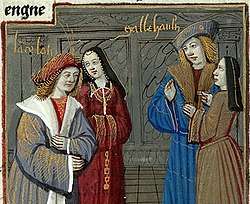Galehaut
Galehaut (or Galaha[l/u]t, Galeho[l]t, Gallehau[l]t, Galehot, Galhault, Galetto, etc.) is a half-giant knight in the Arthurian legend. He is most prominent within the Lancelot-Grail prose cycle where he is a noble enemy turned an ally of King Arthur, as well as an inseparable friend of Arthur's champion Lancelot. Galehaut should not be mistaken with Lancelot's son, Galahad.
In the legend

Galehaut, lord of the Distant Isles (le sire des Isles Lointaines),[1] appears for the first time in the Matter of Britain in the "Book of Galehaut" section of the early 13th-century Prose Lancelot Proper, the central work in the series of anonymous Old French prose romances collectively known as the Lancelot-Grail or the Vulgate Cycle. An ambitious, towering figure of a man, he emerges from obscurity to challenge King Arthur for possession of Arthur's realm of Logres. Though unknown to Arthur and his court, Galehaut has already conquered lands and acquired considerable power, loyal followers, and a reputation for being a noble character. The Vulgate Cycle and the Prose Tristan describe him as "the son of the Fair Giantess" (fils de la Bele Jaiande), given the name Bagotta in La Tavola Ritonda,[2] and the evil human lord Brunor, both of whom are later killed by Tristan who takes over their castle. Galehaut also has a sister, named Delice in the Prose Tristan and Riccarda in Italian romance I Due Tristani.[3]

In the ensuing war, it becomes clear that Galehaut's army is going to win against Arthur's. However, Galehaut is so awed by the battlefield performance of one of Arthur's knights, the mysterious Black Knight, that for his sake he renounces a certain victory and surrenders to Arthur. The knight, who turns out to be the young Lancelot, gratefully accepts Galehaut's companionship. What follows is a tale of friendship, interpreted by some as homosexuality,[4][5][6][7] in which Galehaut figures as the central character as he becomes the tragic hero in the story. Galehaut, just as he has surrendered to Arthur, gives way before Guinevere, yielding Lancelot to her. He also joins Arthur's Knights of the Round Table. He ultimately dies by longing for Lancelot, having been separated with him (Lancelot was first kidnapped by Morgan le Fay and then went mad and disappeared) and after receiving false news of his death. Lancelot, at the end of his own life, is buried next to Galehaut at his castle of Joyous Garde in the tomb that he had built to consecrate and eternalise their companionship. Long after his death, Galehaut continues to be commonly recalled as an exemplar of greatness.
Since the early 13th century, there have been numerous retellings of the life, loves and chivalry of Lancelot's career and the story of his adulterous liaison with Queen Guinevere has always been part of every significant account of King Arthur. The second, overlapping love story, however, the one related in the Prose Lancelot, in which Galehaut sacrifices his power, his happiness, and ultimately his life for the sake of Lancelot, has been largely forgotten. The character himself reappears in a number of Arthurian tales, in several different languages, but without the same significance. The best known retelling in English, the 15th-century Le Morte d'Arthur of Thomas Malory, reduced him to just a relatively villainous minor frenemy of Lancelot's,[8] leaving Guinevere without a rival for Lancelot's affections, besides also relating a part of the Tristan side of the story in the part "The Book of Sir Tristrams de Lyons". In Italian romance Tristano Riccardiano, Galehaut dies of his wound following a duel with Tristan in an attempt to avenge the slaying of his parents, forgiving him in the end.[9]
Legacy
As Dante says in the fifth canto of Inferno, Galehaut was the book that Paolo and Francesca had been reading, when they yield to their love. Dante mentions Galehaut [Inf. V, 137] as both the book itself and the author of it, intermediary between Lancelot and the Queen. And Boccaccio, moved by the great lord's generosity, uses his name as the subtitle of his Decameron ("Il Principe Galeotto"). In Spanish, galeoto is still an archaic word for a pimp.[10]
Subsequent novels, plays, poems, and films have accepted that simplification of the tale. Indeed, so obscure has Galehaut become that modern readers sometimes mistake the name for a mere variant of Galahad. Galahad is the "pure", the "chosen" knight who achieves the quest for the Holy Grail in a part of the Arthurian legend quite distinct from the story in which Galehaut appears. There is no connection between the two figures.
See also
References
- Busby, Keith (2005). Arthurian Literature XXII. DS Brewer.
- La Tavola ritonda, o L'istoria di Tristano: 1: Prefazione, testo dell'opera (in Italian). presso Gaetano Romagnoli. 1864.
- Bruce, Christopher W. (2013). The Arthurian Name Dictionary. Routledge.
- Hyatte, Reginald (1994). The Arts of Friendship: The Idealization of Friendship in Medieval and Early Renaissance Literature. BRILL. ISBN 9789004247017.
- The World and Its Rival: Essays on Literary Imagination in Honor of Per Nykrog. Rodopi. 1999. ISBN 9789042006973.
- Sandra Alvarez (4 January 2010). "Between Guinevere and Galehot: Homo/eroticism in the Lancelot-Grail Cycle". Medievalists.net. Retrieved 10 April 2019.
- Roberts, Anna Klosowska (2016). Queer Love in the Middle Ages. Springer. ISBN 9781137088109.
- Bruce, Christopher W. (2013). The Arthurian Name Dictionary. Routledge.
- Allaire, Gloria; Psaki, Regina (2002). Italian Literature: Tristano Riccardiano. DS Brewer. ISBN 9781843840671.
- galeoto in the Diccionario de la Real Academia Española, 22nd edition. Compare to the role of Pandarus in English culture.
Further reading
- For an English translation of the "Book of Galehaut" within the Prose Lancelot, see vol. 2 of Norris J. Lacy et al., Lancelot-Grail: The Old French Arthurian Vulgate and Post-Vulgate in Translation, 5 vols. (New York-London: Garland [now Routledge], 1993–1996).
- For the evolution of the personage of Galehaut in works subsequent to the Prose Lancelot, see "Translation and Eclipse: The Case of Galehaut" in The Medieval Translator 8, ed. R. Voaden et al. (Turnhout, Belgium: Brepols, 2003): 245–255.